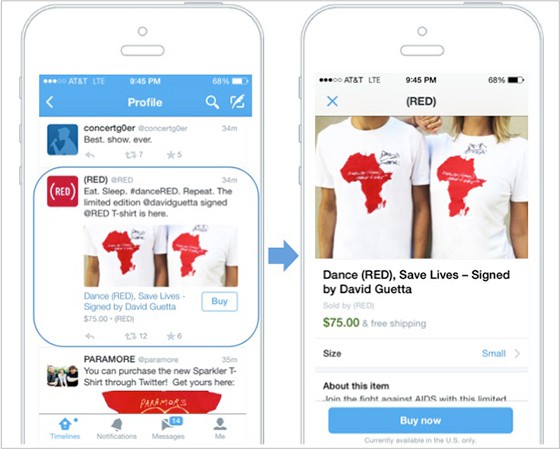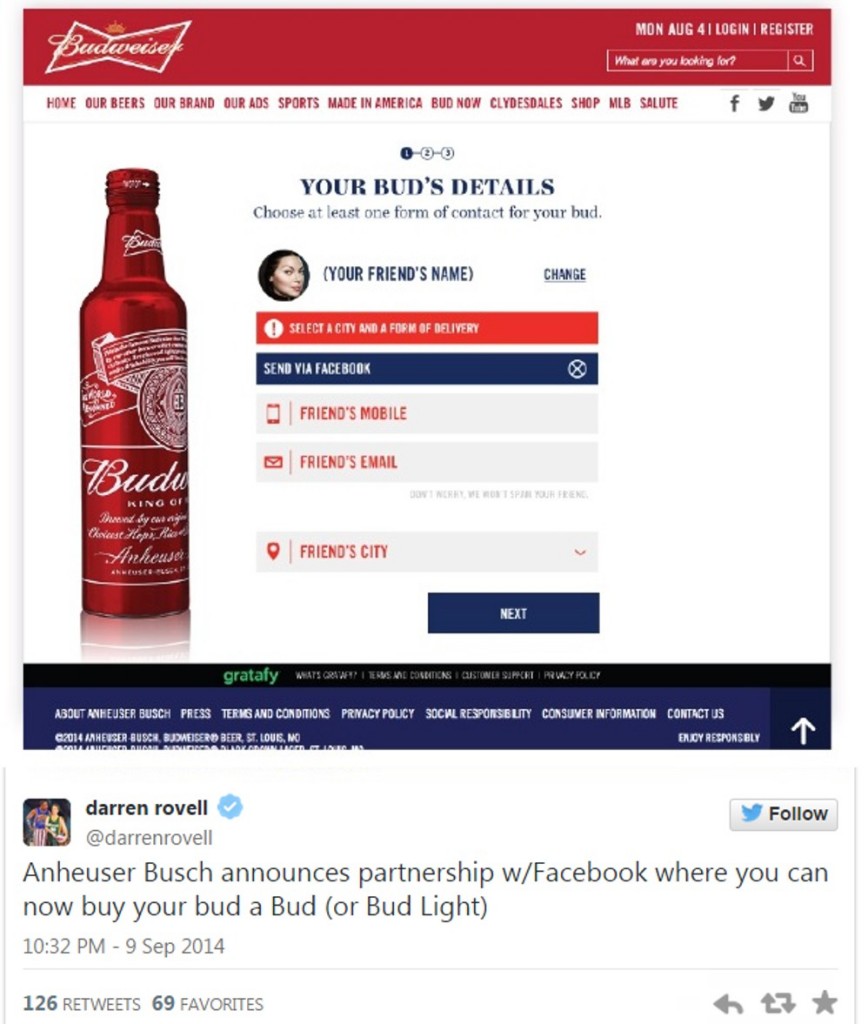跟隨臉書,推特利用「購買鍵」擴展進入電子商務
Twitter已踏入電子商務領域,推出了「購買鍵」,期待創造一個除了廣告之外,嶄新且強勁的收入流。這次的擴展是跟隨了臉書的一個類似的嘗試,並且搶先了今日眾所期待的蘋果(Apple)所宣告的行動商務平台。
推出這個「購買鍵」的同時,伴隨了獨一無二的品牌合作商,從音樂家到零售商,包含阿姆(Eminem)、法瑞爾.威廉姆斯(Pharrell Williams)、雷哈娜(Rihanna)、同性戀反抵毀聯盟(GLAAD)、RED、家得寶(Home Depot)與Burberry。
對少數的推特使用者遷入在po文中,這個按鍵提供了「限量版」或具「時間敏感性」產品的接觸管道。根據推特的公告,「這是在推特中建構功能性當中先邁入的一步,使得行動裝置消費更加便利、簡單,甚至希望有樂趣。」
影片:https://www.youtube.com/watch?v=dEGk5LRumJM
這項科技與線上支付公司Stripe合作,一間期望改變消費者對線上支付想法的新創公司。Stripe的共同創辦人-John Collison說:「你應該要讓『支付』功能在網站上像是用幾行程式碼嵌入一個Youtube影片一樣,你應該要讓它可以立即被執行,這就是網路運作的方式。」Stripe同時也運行阿里巴巴的支付平台。
在點擊推特的「購買鍵」後,會出現輸入支付與配送資訊的提示,並再幾個步驟內,即可確認購買配送,並且資料會儲存以便未來使用。
隨著推特使用者對於線上購買的活躍使用(根據新調查,75%來自世界各地),創造購買是一個對品牌和廣告商服務的自然延伸,也是可以切合他們的使用者行為的關鍵。
前美國購票網站Ticketmaster執行長-Nathan Hubbard,他感受到推特在電子商務所做的努力,並告訴紐約時報:「我認為,推特是一個能連結你所愛的東西的地方,如何能讓一筆交易融入添加進使用經驗呢?」
三位行銷夥伴-社群購物公司Fancy、數位商品服務銷售公司Musictoday及娛樂電子商務公司Gumroad,都和推特和Stripe在產品展示與履行訂單上合作。Hubbard說:「你將會見到當地的廣告變得具交易性,我們已在領導端的領域下投注。」推特也將介紹「購買鍵」功能給他們自身的線上廣告教學機構「Flight School」。
若測試順利,推特可能將「購買文」在動態時報的運算法中的排序提升。推特CFO Anthony Noto告訴華爾街日報: 「若你思考關於搜尋能力的話,我們擁有許多關於議題推文的議題資訊。在搜尋內的排序其實應將其本身歸進分類法。」
推特希望馴服難以估計的內容,並讓使用對於新手來說變得簡易,但許多用戶擔心,引介運算法會破壞推特原有的定義-信息時間流,與此相似的形式還尚未被臉書完全採用。
Marketing Daily指出:「但此處還有一件不可否認的事實,就是那些擁有大量關注的文章勢必有較多的互動,最終也導致他排序在動態時報上方,這同時犧牲掉那些小眾內容的訊息發布者,但無論如何這可能也就是此刻的情勢。」
同時,臉書正持續進行自己的與品牌商合夥的電子商務試驗,其中包括百威啤酒(Budweiser)。兩邊組成贈禮的合作團隊,使得使用者能夠透過社群平台贈與他們的「好兄弟」一罐百威啤酒(或百威Light)。
雖然百威的促銷可能算是「禮物」,但臉書在上個月將禮物平台關閉,將更多心力轉至「購買鍵」,就如同推特,讓使用者能夠不離開臉書平台即可完成交易。
Twitter has dipped a big toe into e-commerce, launching a “Buy” button in the hopes of creating a new and robust revenue stream beyond advertising. The move follows a similar test by Facebook, and precedes what many expect to be an announcement from Apple today about a new mobile commerce platform.
The Buy button launched with an exclusive crop of brand partners, from musicians to retailers, including Eminem, Pharrell Williams, Rihanna, GLAAD, RED, the Home Depot and Burberry.
Embedded in posts for a small number of Twitter users, the button gives access to limited-edition or time-sensitive products. According to Twitter's announcement, “This is an early step in our building functionality into Twitter to make shopping from mobile devices convenient and easy, hopefully even fun."
The technology works with Stripe, a startup that is hoping to change the way consumers think of online payments. “You should be able to drop payments into your website like embedding a YouTube video in a few lines of code. You should be able to do it instantly,” John Collison, Stripe's co-founder, said. “That’s how the internet works.” Stripe is also working with Alibaba's payment platform.
After clicking on the Twitter "Buy now" button, a user is prompted to enter payment and shipping information and in a few clicks, the purchase is confirmed for delivery and that data is stored for future use.
With Twitter users overindexing for online purchases (75 percent worldwide, according to new research), enabling purchases is a natural extension of its offering to brands and advertisers that fits into the sweet spot for its user behavior, too.
After clicking on the Twitter "Buy now" button, a user is prompted to enter payment and shipping information and in a few clicks, the purchase is confirmed for delivery and that data is stored for future use.
With Twitter users overindexing for online purchases (75 percent worldwide, according to new research), enabling purchases is a natural extension of its offering to brands and advertisers that fits into the sweet spot for its user behavior, too.
“I think of Twitter as the place to connect with the things that you love,” Nathan Hubbard, former CEO of Ticketmaster, who now heads up Twitter’s commerce efforts, told the New York Times. “How can you bring a transaction into the experience to make it additive?”
Three marketing partners—Fancy, Musictoday and Gumroad—are working with Twitter and Stripe on product presentation and order fulfillment. "You're going to see native ad units become transactional," said Hubbard. "We've put a stake in the ground at the leading edge of this." Twitter will also be introducing the Buy button in its "Flight School" online ad tutorial for agencies.
If the test goes well, Twitter may soon be elevating "Buy" posts if it incorporates a timeline algorithm. “If you think about our search capabilities we have a great data set of topical information about topical tweets,” Twitter CFO Anthony Noto told the Wall Street Journal. “The hierarchy within search really has to lend itself to that taxonomy.”
Twitter hopes to tame the unwieldy amounts of content and make usage simpler for the neophyte, but many users are concerned that the introduction of an algorithm will disrupt the natural, news-driven rhythm that defines the platform, a similar pattern that has yet to be fully accpeted on Facebook.
“There is a very real point here that those with large followings are likely to get more interaction and end up topping timelines, at the expense of smaller and niche content providers," Marketing Daily notes, "but that is probably the case at the moment anyway."
Facebook, meanwhile is continuing its own test of e-commerce with brand partners including Budweiser. The partners are teaming up on a gifting effort that will allow users to send their "bud" a Budweiser (or Bud Light) through the social platform.
While the Budweiser promotion may be a "gift," Facebook did away with its gifts platform last month to focus more on its Buy button, which, much like Twitter, allows users to complete purchases without ever leaving the Facebook platform.
摘譯自BrandChannel:
http://www.brandchannel.com/home/post/2014/09/09/140909-Twitter-Facebook-ECommerce.aspx
Posted by Sheila Shayon on September 9, 2014 11:28 AM
轉發自: Bpaper品牌好報


沒有留言:
張貼留言